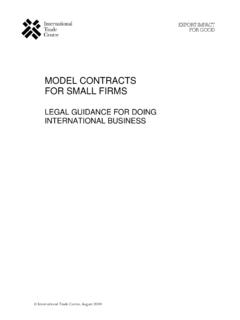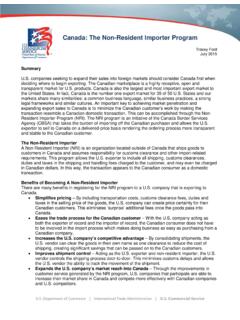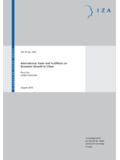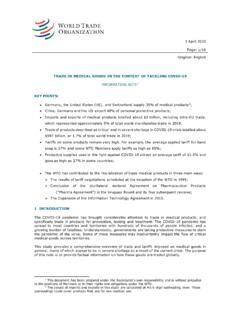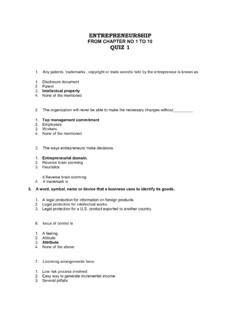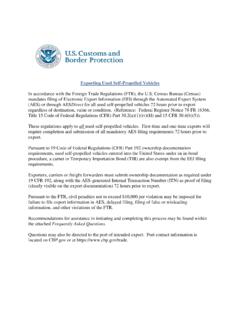Transcription of MODEL CONTRACTS FOR SMALL FIRMS
1 International Trade Centre, August 2010 MODEL CONTRACTS FOR SMALL FIRMS LEGAL GUIDANCE FOR DOING INTERNATIONAL BUSINESS MODEL CONTRACTS for SMALL FIRMS : International Commercial Sale of Goods ii International Trade Centre, August 2010 Contents Foreword Acknowledgements Introduction Chapter 1 International Contractual Alliance Introduction ITC MODEL Contract for an International Contractual Alliance Chapter 2 International Corporate Joint Venture Introduction ITC MODEL Contract for an International Corporate Joint Venture Chapter 3 International Commercial Sale of Goods Introduction ITC MODEL Contract for the International Commercial Sale of Goods (short version)
2 ITC MODEL Contract for the International Commercial Sale of Goods (standard version) Chapter 4 International Long-Term Supply of Goods Introduction ITC MODEL Contract for the International Long-Term Supply of Goods Chapter 5 International Contract Manufacture Agreement Introduction ITC MODEL International Contract Manufacture Agreement Chapter 6 International Distribution of Goods Introduction ITC MODEL Contract for the International Distribution of Goods MODEL CONTRACTS for SMALL FIRMS : International Commercial Sale of Goods International Trade Centre, August 2010 iii Chapter 7 International Commercial Agency Introduction ITC MODEL Contract for an International Commercial Agency Chapter 8 International Supply of Services Introduction ITC MODEL Contract for the International Supply of ServicesModel CONTRACTS for SMALL FIRMS .
3 International Commercial Sale of Goods International Trade Centre, August 2010 1 International Commercial Sale of Goods Introduction This MODEL Contract contains the substantive rules for an international sales contract, the main rights and obligations of the Parties, the remedies for breach of contract by the Buyer; the remedies for breach of contract by the Seller; the general rules that apply equally to both parties. It also contains the boilerplate clauses broadly accepted in international commercial CONTRACTS . The MODEL Contract is greatly influenced by the United Nations Convention on CONTRACTS for the International Sale of Goods (CISG), widely accepted by lawyers of different traditions and backgrounds.
4 It articulates practical requirements arising from commercial practice with the general rules of the CISG. The MODEL Contract can be viewed as a general framework for the numerous types of sales CONTRACTS in international trade. In implementing it, the Parties should adapt it to the nature of each particular sales contract as well as to the specific requirements of the applicable law, where such requirements exist. Attention is drawn on the following points: 1. The MODEL Contract for the International Sale of Goods is presented in two versions the standard and the short one.
5 The standard version contains definitions of relevant notions ( on the concept of lack of conformity), special comments ( on the notice of non-conformity), explanations and/or warnings to the Parties ( on the limitation of the Seller s liability, on the validity of the agreed interest clause). The short version is more practice-oriented, covering the main rights and obligations of the Parties with no special explanations. In addition, the short version contains only selected boilerplate clauses, whereas the standard version provides for all the boilerplate clauses inserted in other MODEL CONTRACTS of this handbook.
6 2. The MODEL Contract can be divided into four parts. The first part lays down rules on the Goods: Delivery, price, payment conditions and documents to be provided. The second part governs the remedies of the Seller in case of non-payment at the agreed time; the remedies of the Buyer in case of non-delivery of goods at the agreed time, lack of conformity of goods, transfer of property and legal defects. The third part contains the rules on avoidance of contract and damages grounds for avoidance of contract, avoidance procedure, effects of avoidance in general, as well as rules on restitution, damages and mitigation of harm.
7 The fourth part contains the standard provisions. 3. The MODEL Contract adopts the CISG concept of lack of conformity. This concept is wider than the concept of material defects (traditionally adopted in civil law countries) and includes differences in quality, as well as differences in quantity, delivery of goods of different kinds and defects MODEL CONTRACTS for SMALL FIRMS : International Commercial Sale of Goods 2 International Trade Centre, August 2010 in packing. Nevertheless, specific cases of non-conformity defined under the CISG largely correspond to how material defects are defined in civil law countries.
8 Such cases include unsuitability of the Goods for ordinary purpose or for particular purpose, as well as non-conformity with a sample or MODEL . Liability of the Seller for non-conformity is dealt with almost identically under the CISG and most national rules dealing with liability of the Seller for material defects. Furthermore, in the system of the CISG, non-delivery and lack of conformity are strictly separate forms of breach of contract. The same system is adopted in this MODEL Contract, specifying: a) special rules on remedies of the Buyer in case of non-delivery at the agreed time; b) special rules on remedies of the Buyer in case of non-conformity of goods; c) general rules on contract avoidance due to non-performance of contractual obligations.
9 4. On contract avoidance (the term avoidance of contract, also taken from the CISG, means termination of contract), the MODEL Contract uses the CISG concept of fundamental breach of contract, but with significant modifications. The MODEL Contract first of all defines cases that constitute a breach of contract (where a party fails to perform any of its obligations under the contract, including defective, partial or late performance). On that basis, the MODEL Contract establishes the rules for two different situations. First is the case where the breach of contract amounts to a fundamental breach.
10 That would be the case where strict compliance of the obligation which has not been performed is of the essence under the contract; or where non-performance substantially deprives the aggrieved party of what it was reasonably entitled to expect. The MODEL Contract also leaves the possibility for the Parties to specify cases which are to be considered as a fundamental breach, late payment, late delivery, non-conformity, etc. In the case of a fundamental breach, the MODEL Contract allows the aggrieved party to declare the contract void, without fixing an additional period of time to perform what is specified in the contract.









